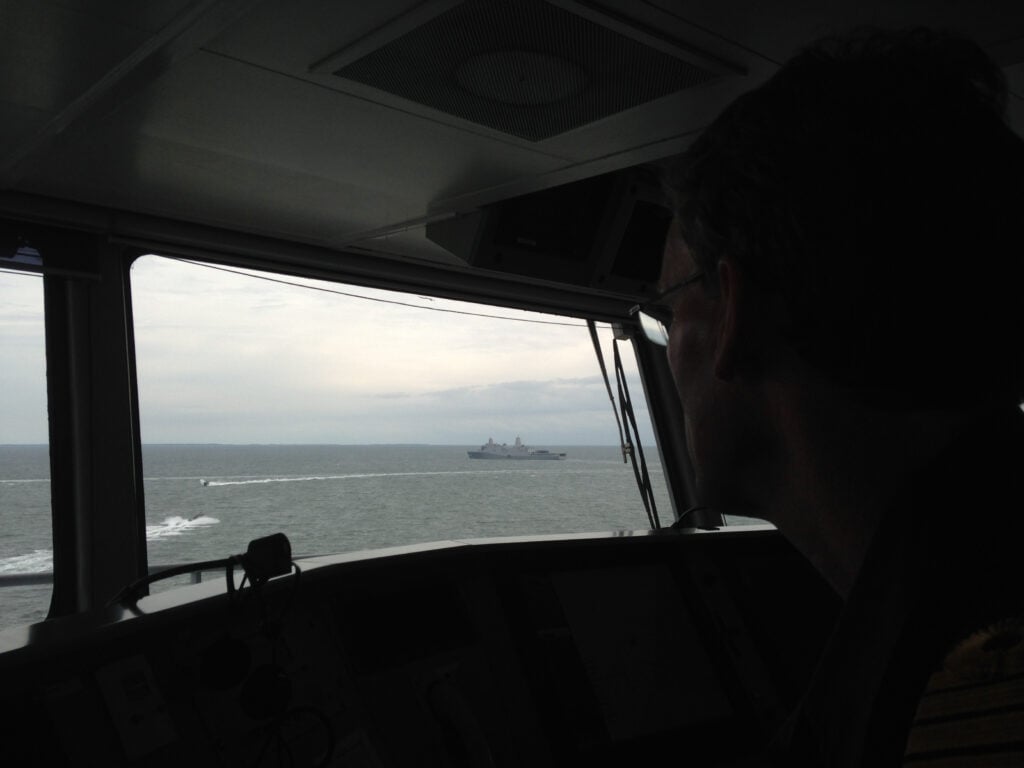
Dutch navy Captain Renee Lucykx watches small craft and the USS Arlington from the bridge of the Dutch ship Johan De Witt.
ABOARD THE USS ARLINGTON: 17 warships and two submarines. Thousands of personnel from 19 countries. Billions of dollars of high-tech hardware. Months of planning. But sometimes you still have to improvise.
When US and Dutch warships and marines united in an international task force for the 2014 Bold Alligator wargames off Virginia, the two countries could not get their communications systems to work together. The solution? Dutch personnel kludged together a tangle of antennas and wired it to the sleek superstructure of the Arlington like somebody stealing cable.
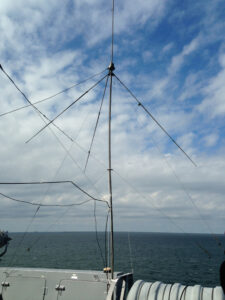
To communicate between US and allied ships, sailors had to jury-rig these antennas on the USS Arlington.
The ad hoc antennas weren’t just an eyesore. They embody, in miniature, all the mundane problems of making international operations work, even with longtime NATO allies. Coalition partners around the world are crucial to US strategy, especially with the American public weary of a 13-year war and wary of further US-led campaigns. But while allied air and ground forces have spent those 13 years learning how to work ever more closely together in landlocked Afghanistan, navies have a lot of catching up to do.
“We used to come here quite often on this side of the ocean, in the nineties,” said René Luyckx, the Dutch captain of the task force flagship, Johan de Witt. “[But] it’s 20 years since I was last in Norfolk.”
“We focused too much on Afghanistan and now it’s time to go back to amphibious operations,” said Dutch marine Col. Sebastian Brust, echoing the sentiments of many US Marines. “I just came back actually from Afghanistan, a year in Kabul” — his third Afghan tour– “[but] now I’m back to the amphibious side of it, which is completely different and more complex.”
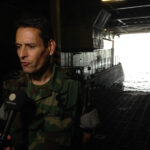
Dutch Marine Colonel Sebastian Brust
That’s why this year’s Bold Alligator exercise emphasized both international participation — for the first time placing a foreign commodore in charge of US vessels — and improvisation. “I’ve been in the Navy for about 30 years and this is the very first time I’ve been able to be under command of a foreign officer, said the Arlington‘s skipper, Cdr. Gregory Baker, who participated in the last live Bold Alligator two years ago. (BA 2013 and 2011 were simulations).
“Probably the biggest difference is that in 2012, it was largely scripted. I could open up the playbook and see what was going to happen in a week,” Baker told me, “whereas [this year] I may have a broad-brush understanding of what’s going to happen” — raids on mock guerrilla bases, non-combatant evacuation operations (NEOs), maybe some humanitarian relief — “but I don’t know how that’s going to transpire [or] exactly when…. You have to do rapid, very rapid planning sometimes.”

Adm. Jonathan Greenert
So there are supposed to be surprises and inelegantly improvised solutions in a wargame like this one. But how do you bridge the gaps between lavishly equipped US forces and often less-well-funded allies?
“If I had that answer as clearly as I’d like to have it, Sydney, we probably could have skipped Bold Alligator,” said the Chief of Naval Operations, Adm. Jonathan Greenert, a few days later at the Brookings Institution. “You don’t really get into those details and find those issues until you bring them [US and allied forces] together.”
For all the ragged edges, the ability to work with partners around the planet — and to improvise around the inevitable glitches — is an enduring advantage of the US military. It’s particularly well-developed in the Pacific, because Japan is the only foreign nation that permanently hosts a US carrier, plus its escorts and amphibious ships.
“We work to improve our interoperability [all year long] and annually we do a large exercise to stress that command and control,” said Rear Adm. John Alexander, who commands the USS George Washington task force. When Alexander called me, he was overseeing the biennial Keen Sword wargames, involving about 20 US and Japanese ships. “It would be harder to do this exercise if we just rolled in once a year,” he told me.
But even where the US Navy does not have such year-round relationships, it still makes frequent visits to allies and potential partners that let it at least start to work the kinks out. Contrast China, whose rapidly growing fleet recently participated for the first time ever in the multinational Rim of the Pacific exercises.
“They’ve operated in among themselves, but not internationally,” Greenert said of the Chinese. “So I think they have a pretty good learning curve to take on. We saw it in RIMPAC. They started out [doing] sort of rudimentary exercises, had some problems maybe here and there — not unexpected for somebody entering into a multilateral engagement — but they ramped up reasonably well.”
That’s a learning curve the US and its allies want to stay ahead of.
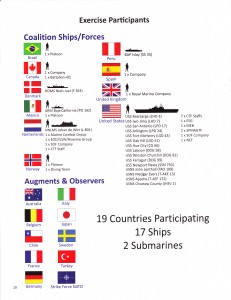
Nations participating in Bold Alligator 2014
Interoperability, Improvisation, & Intervention
To paraphrase Doctor Johnson, the trick about coalition warfare isn’t doing it well: It’s doing it at all.
“Being here is a success already for us, being the heart of coalition forces,” said Dutch Commodore Rob Kramer, commanding four ships — one Dutch, one Danish, two American — and a host of smaller vessels and aircraft.
That’s a remarkable level of integration. In the Keen Sword exercise, despite the decades of US-Japanese cooperation and close work between the two navies’ staffs, Rear. Adm. Alexander told me the two countries retained a “parallel command structure” — not a single chain of command with a foreign officer issuing orders to American warships as Kramer did in Bold Alligator.
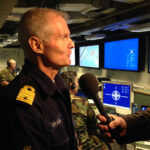
Dutch Commodore Rob Kramer aboard the De Witt
“If we in the end understand each other better and we’ve tested interoperability, I would call this a large success,” Kramer told me. Behind him, in the operations center of the task force flagship, the de Witt, labored an eclectic collection of Dutch personnel (army, navy, and marines) mixed with US marines, British Royal Marines, and a lone Belgian sailor. In a rec room not far away, young Canadian soldiers played RISK between missions. All told, the de Witt had 600 personnel aboard from 13 nations.
“One of the biggest challenges we’re always facing is communications,” Kramer said — hence the ad hoc antenna on the Arlington. While many lessons from landlocked Afghanistan don’t translate to naval operations, he said, communications network technology is one thing that does carry over.
De Witt is a pretty sophisticated ship, as its skipper, Capt. Luyckx, was glad to tell me. Just six years old, the de Witt has not only the usual berthing for marines, medical facilities, landing craft, and a well deck, he said, “we also have a special deck for a command and control facility, so this ship is able to run operations like counter-piracy in the Indian Ocean for a whole coalition.” In fact, when Sweden takes its turn leading the European Union counter-piracy task force off Somalia next year, they’ll be embarking their command staff on the de Witt rather than one of their own ships.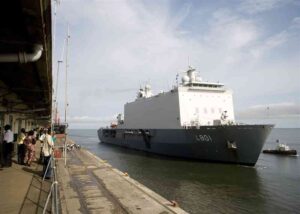
The 15,500-ton metric de Witt‘s weakness — like that of many European ships — is not electronic but physical: It’s built to commercial standards of damage control. That makes it significantly less survivable even than the US Navy’s controversial Littoral Combat Ship, let alone a 25,000-ton amphibious assault ship like the Arlington.
The Arlington belongs to the LPD-17 San Antonio class, which has much more sophisticated command-and-control facilities than older amphibs of similar size. “The sky is the limit,” Commander Baker boasted.
That said, the Navy generally lags the ground forces in communications kit, and Arlington‘s no exception. This is still a gap between what ships can handle and what Marines bring aboard, for instance, Baker acknowledged, although “it’s less than it used to be.” A particular issue for the Arlington is that, while the Navy is upgrading the whole fleet, eventually, to a new shipboard computer system called CANES, the LPD-17 class has an earlier and not entirely successful attempt at an all-in-one network called SWAN (Shipboard Wide Area Network).
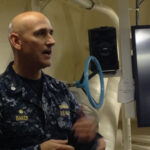
Commander Baker
“Marines can plug in pretty much wherever they want. Heck they can go to a McDonald’s and do Marine stuff,” said Baker. “[But] when that computer comes aboard, it has to be compatible with our SWAN” — or it can’t get access to any network at all.
Interoperability with the allies — which relies on a different network called CENTRIX — is even “more challenging,” Baker added.
These technical problems have tactical, operational, and even strategic significance. The 2012 Defense Strategic Guidance calls for more cooperation with allies in crisis response interventions all around the world. There won’t be years to build up infrastructure and work out the bugs, as there was in Afghanistan and, even more so, in Western Europe during the Cold War. That puts a premium on both improvisation and peacetime training to identify problems in advance.
The Marine Corps in particular wants to move towards a “come as you are” kind of operations, enshrined in their new Expeditionary Force 21 concept released this April. That’s part of why Bold Alligator 2014 is less scripted and more international than the 2012 iteration.
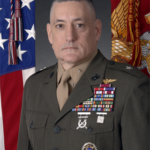
Brig. Gen. David Coffman
“We designed the exercise quite a bit differently,” Marine Brig. Gen. David Coffman told reporters. “A traditional [Marine Corps] operation would be load everybody up, do a lot of detailed planning, maybe move to a [staging] area and rehearse what you’re going to do, and eventually get to a theater of operations and do your amphibious assault or whatever your missions are,” he said. “We don’t believe it’s going to work that way.”
Instead, the Bold Alligator 2014 scenario begins with a crisis in a fictional country with a small Marine Expeditionary Unit — about 2,200 troops — nearby. Rather than wait for reinforcement, the MEU responds quickly on its own. Then both US and allied forces flow in as fast as they can from wherever they are. “Compositing” forces this way means the command-and-control arrangements won’t be in place beforehand but must rapidly scale up to accommodate a growing force from a growing number of nations.
“This is the first time in this [exercise] series that we have done it that way,” said Coffman, “which is very challenging to our doctrine and our concepts.” That’s why the US and its allies are going to need a lot of practice.
Edited Friday 10:45 am
Multi-ship amphib buy could net $900M in savings, say Navy, Marine Corps officials
Lawmakers gave the Navy authorities to ink a multi-ship amphib deal years ago, but the service has not utilized that power yet.


























